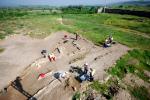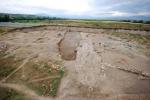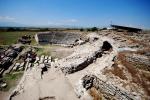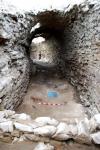Summary (English)
During 2013, National Institution Stobi realized 3 excavation projects as well as 8 projects for conservation and restoration of architecture and moveable finds.
The first excavation campaign in April, May and June included investigations at the Western Necropolis and the Theatre, financed through the capital projects for excavations supported by the Government of the Republic of Macedonia. Besides the 13 graves uncovered at the Western Necropolis, the imperative of the NI Stobi archaeologists was the street that leads from Porta Heraclea to the south. Given that the graves are arranged on both sides of the street, significant information for the development and the organization of the necropolis was brought to light. The grave offerings documented included ceramic vessels, a glass vessel, many terracotta figurines and two iron strigils.
The excavations at the theatre were concentrated in the eastern half of the central circular corridor, which is 35 metres in length and 2.5 metres in width. The habitation deposits from Late Antiquity and the Medieval Period were the principal subject of the excavations. The new interesting information is that the corridor was used as part of the dwellings erected above the theatre during the 6th century and later during the 11-12th centuries. Four secondary entrances were opened between some of the radial walls of the ima cavea in order to approach the central corridor from the newly- built houses.
The second excavation project i.e. the International Field School co-organized with the Balkan Heritage Foundation took place in August. Participants from several different countries during the two sessions (15 days each) were directly involved in the excavation and documentation process of two rooms from a 6th century building, located near the Porta Heraclea. A particularly interesting discovery was the three infant graves dug in the hard-packed earthen floors of the both rooms.
The excavations in August and September, along the western foundation of the Temple of Isis, revealed the deposits before the construction which indicate that in the earlier period the area served for deposit of debris. A few pottery sherds from the Iron Age (7th century BC), the Classical period (4th century BC) and the Hellenistic period (3-2 centuries BC) were found among the dominant material from the 1st century AD. A large number of fresco fragments were discovered together with the 1st century pottery.
Director
- Silvana Blazevska - National Institution Stobi
Team
- Dimitar Nikolovski - NI Stobi
- Goce Pavlovski - NI Stobi
- Zlatko Kovancaliev - NI Stobi
Research Body
- National Institution Stobi
Funding Body
- Government of the Republic of Macedonia





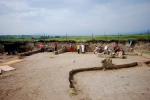
![Download [PDF]](/excavation/skins/fasti/images/results/download_sml.png)
